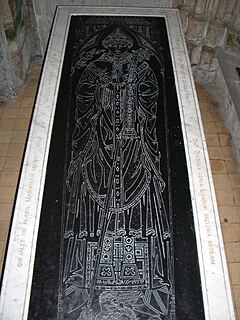Related Research Articles
Erard I, Count of Brienne (1060–1114) was Count of Brienne at the end of the 11th century. He was the son of Gautier I of Brienne, count of Brienne, and his wife Eustachie of Tonnerre.
Ebles I of Roucy was count of Roucy from 1000 to 1033 and archbishop of Reims from 1021 to 1033.
Ebles II, also called Eble or Ebale, was the second Count of Roucy (1063–1103) of the House of Montdidier. He was the son and successor of Hilduin IV of Montdidier and Alice (Alix), daughter of Ebles I of Roucy. He is famous for his participation in the Reconquista, as well as for being one of the unruly barons of the Île-de-France subjugated by King Louis VI while he was still a prince. His life and character are summed up by Suger in his history of the reign of Louis VI: "Ebles was a man of great military prowess—indeed he became so bold that one day he set out for Spain with an army of a size fit only for a king—his feats of arms only made him more outrageous and rapacious in pillage, rape and all over evils."

Barthélemy de Jur was a French bishop. He was bishop of Laon from 1113 to 1151. Some documents give his name as Barthélemy de Grandson or de Joux.
The name Dammartin-en-Goële comes from Domnus Martinus, the Latin name of St. Martin of Tours, who evangelized the region of Goële in the fourth century. A small town in the district of Meaux in the Department of Seine-et-Marne, ancient village of Region of Île-de-France, it appears to go back to the earliest times; Dammartin-en-Goële, also called Velly, was in 1031 one of the most significant places in France.

Ermentrude de Roucy (Irmtrude) was a Countess and Duchess of Burgundy.
Gilbert, Count of Reims & Roucy, was the son of Renaud, Count of Reims and Alberade of Lorraine, daughter of Gilbert, Duke of Lorraine. Although his wife's name is unknown, she was likely from the family of the Poitiers. He was Count of Roucy from 967 until his death, and Viscount of Reims.
Arnold I, Count of Chiny, son of Louis II, Count of Chiny, and his wife Sophie. He succeeded his father as count before 1066.
Hilduin I, Count of Montdidier. It is unknown who the parents of Hilduin were. Hilduin was the founder of the House of Montdidier, which produced the Counts of Montdidier, Dammartin and Roucy.
Hilduin II, Count of Arcis-sur-Aube, Seigneur de Ramerupt, son of Hilduin I, Count of Montdidier, and Heresende. Hilduin II was a member of the House of Montdidier.
Hilduin III, Count of Montdidier, Seigneur de Ramerupt, son of Hilduin II, Count of Arcis-sur-Aube. He was a member of the House of Montdidier. Virtually nothing is known about his life.
Manasses, Count of Dammartin (Dammartin-en-Goële), son of Hilduin II, Count of Arcis-sur-Aube and Seigneur de Ramerupt. He was a member of the House of Montdidier. His Latin nickname was Calvus – the Bald,.
Hilduin IV, Count of Montdidier and Lord of Ramerupt, son of Hilduin III, Count of Montdidier, member of the House of Montdidier. Hilduin was also Count of Roucy by virtue of his marriage to the daughter of Ebles I, Count of Roucy.
Manasses, son of Hilduin III, Count of Montdidier. He was often mistaken for his uncle Manasses, Count of Dammartin.
Rotrou I, Viscount of Châteaudun and Count of Perche, son of Geoffrey II, Viscount of Châteaudun, and Helvise de Corbon, daughter of Rainard, Lord of Pithiviers.
Geoffrey II, Count of Mortagne and Count of Perche, son of Rotrou I, Viscount of Châteaudun, and Adelise de Bellême, daughter of Guérin de Domfront. Geoffrey was Count of Mortagne and Seigneur of Nogent from 1060 to 1090, and Count of Perche from 1090 until his death.
Hugues IV, Viscount of Châteaudun, son of Geoffrey III, Viscount of Châteaudun, and Helvise, Dame of Mondoubleau, daughter of Ilbert “Payen” de Mondoubleau. He became Lord of Mondoubleau upon his mother’s death, based on her inheritance, and acquired the lordship of Saint-Calais by marriage.
Hugh I, Count of Clermont-en-Beauvaisis (1030–1101), son of Renaud I of Clermont (1010–1088), son-in-law of Baldwin II of Clermont, the second known Count of Clermont. Hugh was an early founder of the House of Clermont.
The House of Clermont is a noble family of the French region of Picardy dating from the 10th century and included both the early counts of Clermont-en-Beauvaisis as well as many Constables of France. The house eventually merged with the House of Nesle with the marriage of Raoul II of Clermont and Gertrude of Nesle. The family is the sometimes referred to as the House of Clermont-Nesle.
References
- ↑ Medieval Lands Project
- ↑ Foundation for Medieval Genealogy [archive]
- ↑ La fondation du prieuré de Saint-Leu d’Esserent [archive]
- ↑ The Genealogiæ Scriptoris Fusniacensis mentions four but identifies three.
- ↑ See Article IV of Montdidier Hildouin to have the list.
- ↑ He is named Guiscard or Wiscardus in most contemporary documents, but later historians call him Robert Guiscard without knowing why the first name Robert was added.